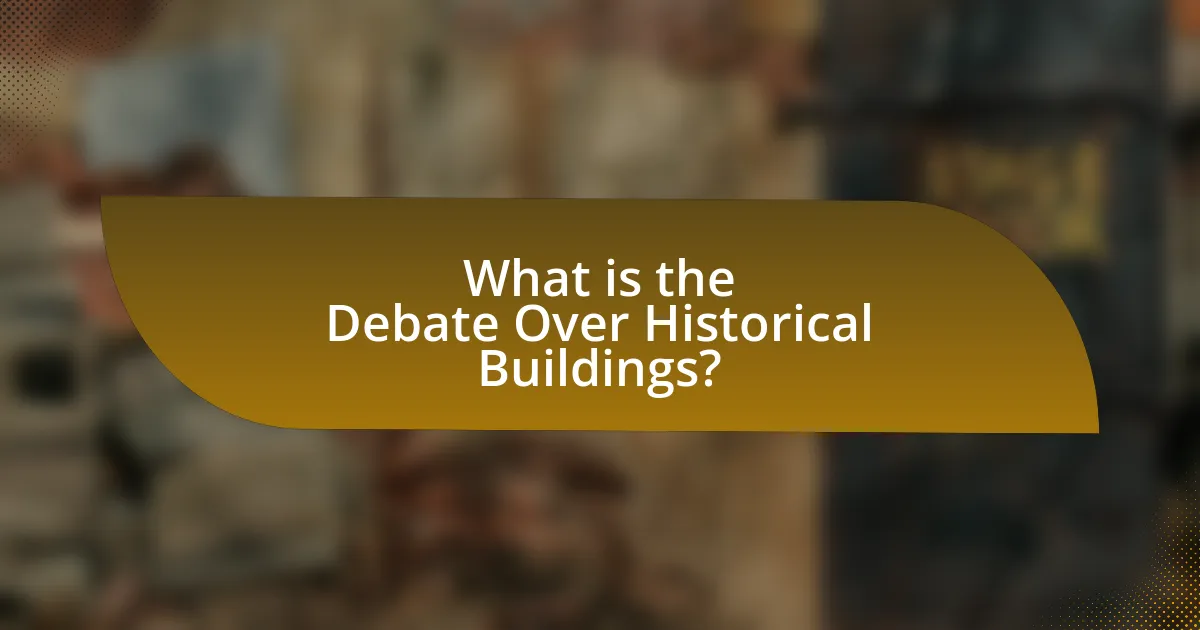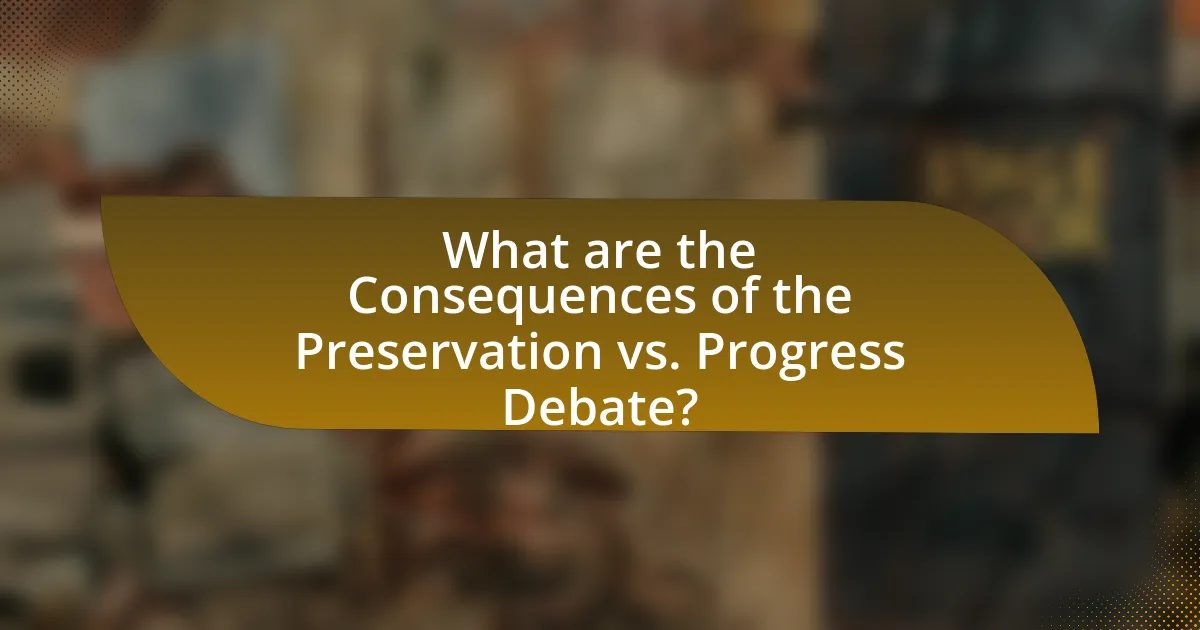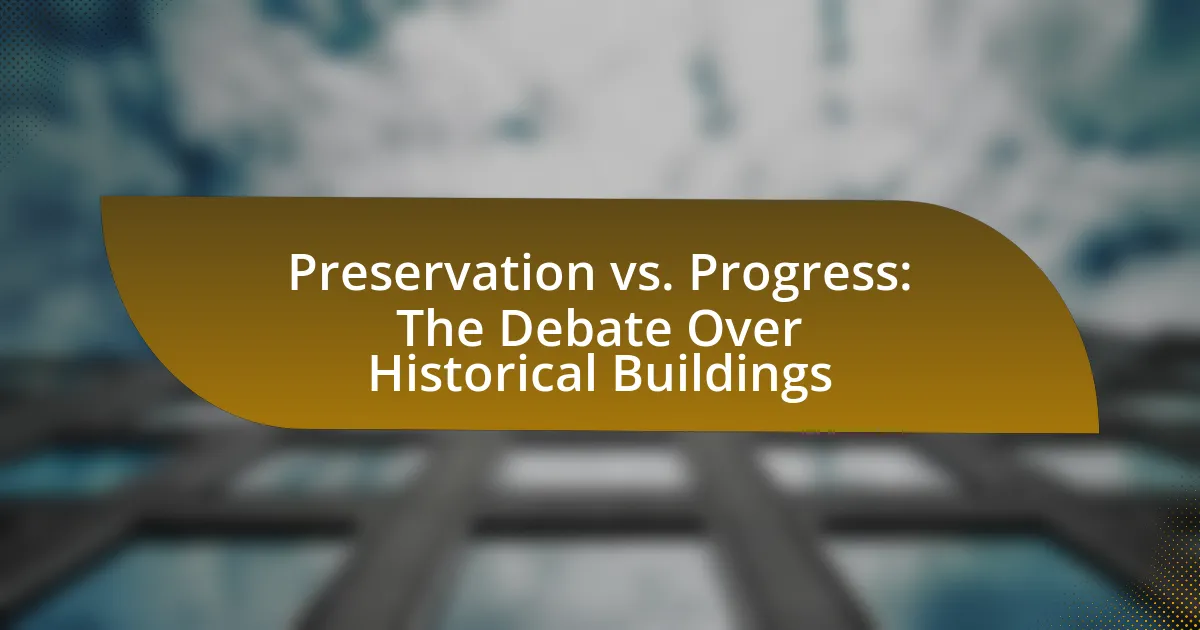The article examines the ongoing debate over historical buildings, focusing on the tension between preservation of cultural heritage and the demands of modern urban development. It highlights the importance of historical buildings in maintaining community identity, enhancing tourism, and fostering economic growth, while also addressing the arguments for progress that emphasize the need for new infrastructure and improved living conditions. Key stakeholders, including preservationists, urban developers, and local communities, are discussed in terms of their perspectives and the challenges they face in balancing preservation with modernization. The article further explores the implications of this debate on cultural heritage, urban landscapes, and potential strategies for achieving a harmonious approach to urban planning.

What is the Debate Over Historical Buildings?
The debate over historical buildings centers on the conflict between preserving cultural heritage and accommodating modern development needs. Advocates for preservation argue that historical buildings hold significant cultural, architectural, and historical value, contributing to community identity and tourism. For instance, the National Trust for Historic Preservation emphasizes that such structures can enhance local economies and foster a sense of place. Conversely, proponents of progress argue that outdated buildings can hinder urban development, economic growth, and the creation of modern infrastructure. They contend that new construction can better meet contemporary needs and improve living conditions. This ongoing discussion reflects broader societal values regarding heritage conservation versus the necessity for modernization.
Why is the preservation of historical buildings important?
The preservation of historical buildings is important because it maintains cultural heritage and identity. Historical buildings serve as tangible connections to the past, allowing communities to understand their history and traditions. For instance, UNESCO recognizes over 1,000 World Heritage Sites, emphasizing the global significance of preserving structures that reflect cultural narratives and architectural achievements. Furthermore, studies show that heritage tourism, which relies on preserved historical sites, can significantly boost local economies, demonstrating the practical benefits of maintaining these structures alongside their cultural value.
What cultural values do historical buildings represent?
Historical buildings represent cultural values such as heritage, identity, and continuity. These structures serve as tangible links to the past, reflecting the architectural styles, social norms, and historical events of their time. For instance, the preservation of buildings like the Parthenon in Greece symbolizes ancient democratic ideals and artistic achievement, while colonial-era structures in various countries illustrate the complexities of cultural exchange and conflict. Such buildings foster a sense of belonging and community pride, reinforcing local identities and traditions.
How do historical buildings contribute to community identity?
Historical buildings contribute to community identity by serving as tangible representations of a community’s heritage and cultural values. These structures often embody the architectural styles, historical events, and social narratives that define a community’s unique character. For instance, a study by the National Trust for Historic Preservation found that communities with preserved historical buildings experience a stronger sense of place and belonging among residents, as these buildings foster connections to the past and enhance local pride. Additionally, historical buildings can attract tourism, further reinforcing community identity by showcasing local history and culture to visitors.
What are the arguments for progress in urban development?
Arguments for progress in urban development include economic growth, improved infrastructure, and enhanced quality of life. Economic growth is driven by new developments that attract businesses and create jobs; for instance, urban areas that have embraced modern construction often see a rise in employment rates and local investment. Improved infrastructure, such as transportation systems and utilities, facilitates better connectivity and efficiency, which is essential for urban expansion. Additionally, enhanced quality of life is achieved through the creation of modern amenities, green spaces, and housing that meet contemporary needs, leading to increased resident satisfaction and community engagement. These factors collectively support the notion that progress in urban development is vital for adapting to changing societal demands and fostering sustainable growth.
How does urban development impact economic growth?
Urban development significantly impacts economic growth by enhancing infrastructure, attracting investments, and increasing job opportunities. Improved infrastructure, such as transportation and utilities, facilitates business operations and reduces costs, leading to higher productivity. For instance, cities that invest in public transit systems often see a rise in local business revenues; a study by the American Public Transportation Association found that every $1 invested in public transit generates approximately $4 in economic returns. Additionally, urban development attracts both domestic and foreign investments, as businesses seek locations with modern amenities and a skilled workforce. This influx of capital creates new job opportunities, further stimulating economic activity. Overall, urban development serves as a catalyst for economic growth through infrastructure improvements, investment attraction, and job creation.
What are the benefits of modern architecture in cities?
Modern architecture in cities enhances functionality, sustainability, and aesthetic appeal. It often incorporates innovative materials and designs that optimize space and energy efficiency, contributing to reduced environmental impact. For instance, buildings designed with green roofs and energy-efficient systems can lower energy consumption by up to 30%, as reported by the U.S. Green Building Council. Additionally, modern architecture promotes urban revitalization by transforming underutilized areas into vibrant spaces that attract businesses and residents, fostering economic growth. This approach not only addresses contemporary needs but also reflects the evolving identity of urban environments.
What challenges arise in balancing preservation and progress?
Balancing preservation and progress presents challenges such as conflicting interests between stakeholders and financial constraints. Stakeholders, including developers, local governments, and preservationists, often have differing priorities; for instance, developers may prioritize economic growth while preservationists focus on maintaining historical integrity. Financial constraints further complicate this balance, as funding for restoration projects can be limited, making it difficult to implement modern infrastructure without compromising historical value. According to a report by the National Trust for Historic Preservation, nearly 60% of preservation projects face budget overruns, highlighting the financial difficulties in reconciling these two objectives.
How do financial constraints affect preservation efforts?
Financial constraints significantly hinder preservation efforts by limiting the resources available for maintenance, restoration, and protection of historical buildings. When funding is insufficient, essential repairs may be deferred, leading to deterioration and potential loss of structural integrity. For instance, a study by the National Trust for Historic Preservation found that inadequate funding can result in a 30% increase in restoration costs over time due to neglect. Additionally, financial limitations often force organizations to prioritize immediate needs over long-term preservation goals, compromising the integrity of historical sites.
What role do government regulations play in this debate?
Government regulations play a crucial role in the debate over historical buildings by establishing legal frameworks that protect cultural heritage while balancing development needs. These regulations often include zoning laws, preservation ordinances, and guidelines for renovations, which aim to maintain the historical integrity of buildings. For instance, the National Historic Preservation Act of 1966 in the United States provides a systematic approach to preserving historical sites, requiring federal agencies to consider the impact of their actions on historic properties. This legal structure influences decisions made by developers and local governments, often leading to conflicts between preservation advocates and those seeking modernization or redevelopment.

How do Different Stakeholders View the Debate?
Different stakeholders view the debate over historical buildings through distinct lenses shaped by their interests and values. Preservationists advocate for maintaining historical integrity, emphasizing the cultural and educational significance of these structures, often citing studies that show preserved buildings enhance community identity and tourism revenue. Developers, on the other hand, prioritize economic growth and urban development, arguing that repurposing or demolishing old buildings can lead to modern infrastructure that meets current needs, supported by data indicating that new developments can stimulate local economies. Local governments often find themselves balancing these perspectives, weighing the benefits of historical preservation against the potential for economic development, as seen in policies that aim to protect heritage while allowing for urban renewal.
What perspectives do preservationists hold?
Preservationists hold the perspective that historical buildings and sites are vital cultural assets that should be protected for future generations. They argue that these structures embody significant historical, architectural, and social values, contributing to community identity and heritage. Preservationists often cite studies indicating that maintaining historical buildings can enhance local economies through tourism and community engagement, as seen in cities like Savannah, Georgia, where preservation efforts have led to increased tourism revenue. Additionally, they emphasize the environmental benefits of reusing existing structures, which reduces waste and conserves resources compared to new construction.
How do preservationists advocate for historical buildings?
Preservationists advocate for historical buildings through a combination of public awareness campaigns, legal protections, and community engagement. They often organize educational programs and events to highlight the cultural and historical significance of these structures, aiming to foster appreciation among the public. Additionally, preservationists work to secure landmark status for buildings, which can provide legal protections against demolition or inappropriate alterations. For instance, the National Historic Preservation Act of 1966 in the United States established a framework for protecting significant historical sites, demonstrating the effectiveness of legal advocacy in preserving architectural heritage.
What strategies do preservationists use to raise awareness?
Preservationists use various strategies to raise awareness about the importance of historical buildings. These strategies include community engagement initiatives, educational programs, social media campaigns, and partnerships with local organizations. For instance, community engagement initiatives often involve organizing public forums and workshops to discuss the value of preservation, which can lead to increased local support and participation. Educational programs in schools and community centers help inform the public about the historical significance of buildings, fostering a sense of pride and responsibility. Social media campaigns leverage platforms like Facebook and Instagram to reach a broader audience, sharing stories and visuals that highlight the cultural heritage of specific sites. Additionally, partnerships with local organizations can amplify efforts, as collaborative events and joint campaigns can draw more attention and resources to preservation efforts. These strategies collectively enhance public understanding and support for preserving historical buildings.
What are the views of urban developers and architects?
Urban developers and architects generally prioritize progress and modernization, advocating for new developments that meet contemporary needs and enhance urban functionality. They argue that revitalizing urban spaces through new construction can stimulate economic growth, improve infrastructure, and address housing shortages. For instance, a study by the Urban Land Institute highlights that urban redevelopment projects can lead to increased property values and job creation, demonstrating the tangible benefits of modernizing urban environments. However, many urban developers and architects also recognize the importance of preserving historical buildings, as these structures contribute to cultural identity and community character. Balancing these perspectives is crucial in the ongoing debate over how to approach urban development while respecting historical significance.
How do urban developers justify the need for new constructions?
Urban developers justify the need for new constructions by highlighting the demand for housing, commercial spaces, and infrastructure to accommodate growing populations and economic activities. They often cite statistics indicating population growth in urban areas, such as the United Nations projecting that 68% of the world’s population will live in urban areas by 2050, necessitating additional housing and services. Furthermore, developers argue that new constructions can revitalize declining neighborhoods, improve local economies, and provide modern amenities that meet current standards of living. This justification is supported by studies showing that new developments can lead to increased property values and job creation, thereby contributing to overall urban development and sustainability.
What innovations do architects propose to integrate history with modernity?
Architects propose innovations such as adaptive reuse, which involves repurposing historical buildings for modern functions while preserving their original character. This approach not only maintains the cultural significance of the structures but also reduces waste and resource consumption, aligning with sustainable practices. For instance, the High Line in New York City transformed an abandoned elevated railway into a public park, integrating historical elements with contemporary design. Additionally, architects utilize modern materials and technologies, like glass and steel, to create contrasting yet complementary structures that respect historical contexts, as seen in the Louvre Pyramid designed by I.M. Pei. These innovations demonstrate a commitment to honoring history while embracing modernity.
How do local communities influence the debate?
Local communities significantly influence the debate over historical buildings by voicing their opinions, mobilizing for preservation, and participating in local governance. Their collective actions can sway decision-makers, as seen in numerous cases where community-led initiatives have successfully halted demolition projects in favor of preservation efforts. For example, in 2019, the community of New Orleans rallied to protect the historic St. John the Baptist Church, leading to a city council vote that favored restoration over redevelopment. This illustrates how local sentiment and organized advocacy can directly impact the outcomes of debates surrounding historical preservation versus progress.
What role do community opinions play in preservation decisions?
Community opinions significantly influence preservation decisions by reflecting the values and priorities of local stakeholders. When communities express their views on historical buildings, these opinions can shape policy-making, funding allocations, and the overall approach to preservation efforts. For instance, studies have shown that public support for preserving historical sites often leads to increased funding and resources allocated for their maintenance and restoration. Additionally, community engagement in preservation initiatives fosters a sense of ownership and responsibility, which can enhance the effectiveness of preservation strategies.
How can community engagement enhance preservation efforts?
Community engagement enhances preservation efforts by fostering local ownership and support for historical sites. When community members actively participate in preservation initiatives, they develop a deeper connection to their cultural heritage, which can lead to increased advocacy and funding for preservation projects. Studies show that communities with strong engagement in preservation activities often see higher rates of successful restoration and maintenance of historical buildings. For instance, the National Trust for Historic Preservation reports that local involvement can lead to a 30% increase in funding for preservation projects, demonstrating the tangible benefits of community participation in safeguarding historical assets.

What are the Consequences of the Preservation vs. Progress Debate?
The consequences of the preservation versus progress debate primarily involve the impact on cultural heritage, urban development, and community identity. Preservation advocates argue that maintaining historical buildings fosters cultural continuity and enhances community identity, as evidenced by studies showing that preserved sites can increase local tourism by up to 30%. Conversely, proponents of progress emphasize the need for modern infrastructure and economic development, which can lead to increased job creation and improved living standards. However, this often results in the loss of historical sites, which can diminish a community’s unique character and historical narrative. The debate thus creates a tension between safeguarding cultural heritage and pursuing economic growth, influencing policy decisions and community planning.
What are the potential impacts on cultural heritage?
The potential impacts on cultural heritage include loss of historical identity, degradation of physical structures, and diminished community engagement. When historical buildings are demolished or altered for modern development, the unique architectural styles and cultural narratives they represent can be erased, leading to a homogenization of urban landscapes. For instance, UNESCO reports that over 1,000 cultural heritage sites are at risk due to urbanization and neglect, highlighting the urgent need for preservation efforts. Additionally, the removal of these structures can disrupt local communities’ sense of place and belonging, as these buildings often serve as focal points for cultural activities and social interactions.
How does neglecting preservation affect historical narratives?
Neglecting preservation significantly distorts historical narratives by erasing physical evidence of past events and cultures. When historical buildings and artifacts are not maintained, the context and authenticity of historical experiences are lost, leading to incomplete or inaccurate representations of history. For instance, the destruction of the ancient city of Palmyra in Syria by ISIS resulted in a loss of cultural heritage that altered the understanding of trade and cultural exchange in the region. This loss not only affects academic research but also impacts public memory and identity, as communities often rely on preserved sites to connect with their history.
What are the long-term effects of losing historical buildings?
The long-term effects of losing historical buildings include cultural erosion, economic decline, and diminished community identity. Cultural erosion occurs as unique architectural styles and historical narratives are lost, leading to a homogenized urban landscape. Economic decline can result from decreased tourism, as historical sites often attract visitors; for instance, cities like Rome and Paris generate significant revenue from their preserved historical architecture. Additionally, diminished community identity arises when residents lose tangible connections to their heritage, which can lead to a lack of pride and engagement in local history. These effects collectively contribute to a weakened sense of place and belonging within communities.
How does this debate affect urban landscapes?
The debate over preservation versus progress significantly impacts urban landscapes by influencing architectural development and urban planning decisions. When historical buildings are preserved, they contribute to a city’s cultural identity and heritage, often attracting tourism and enhancing community pride. Conversely, prioritizing progress can lead to modern developments that may increase economic growth but can also result in the loss of historical character and community cohesion. For instance, cities like Paris and Rome have successfully integrated modern infrastructure while preserving their historical sites, demonstrating that a balanced approach can enhance urban landscapes. This balance is crucial as it shapes the aesthetic, social, and economic dimensions of urban environments.
What changes occur in city aesthetics due to new developments?
New developments significantly alter city aesthetics by introducing modern architectural styles, altering skyline profiles, and changing the visual landscape. For instance, the construction of high-rise buildings can overshadow historical structures, creating a juxtaposition that may detract from the character of older neighborhoods. Additionally, new developments often incorporate contemporary materials and design elements that contrast with traditional architecture, leading to a visual dissonance in the urban environment. Research indicates that cities like Chicago and New York have experienced shifts in aesthetic appeal due to the integration of glass and steel structures, which can overshadow historical brick buildings, thereby impacting the overall perception of the city’s heritage and identity.
How can a balance be achieved in urban planning?
A balance in urban planning can be achieved by integrating historical preservation with modern development needs. This involves creating zoning laws that protect historical sites while allowing for new construction that complements the existing architecture. For instance, cities like Paris have successfully implemented regulations that require new buildings to harmonize with the historical aesthetic, ensuring that modern progress does not overshadow cultural heritage. Additionally, community engagement in the planning process fosters a sense of ownership and respect for historical sites, leading to more thoughtful development decisions.
What best practices can be adopted for a balanced approach?
A balanced approach to the preservation of historical buildings involves integrating conservation efforts with modern development needs. Best practices include conducting thorough assessments of historical significance, engaging community stakeholders in decision-making, and implementing adaptive reuse strategies that allow for contemporary use while maintaining historical integrity. For instance, the National Trust for Historic Preservation emphasizes the importance of public involvement in preservation efforts, which can lead to more sustainable outcomes that respect both heritage and progress. Additionally, utilizing guidelines from organizations like the Secretary of the Interior’s Standards for the Treatment of Historic Properties can ensure that renovations honor the original architecture while accommodating modern functionality.
How can cities implement successful preservation policies?
Cities can implement successful preservation policies by establishing clear regulations that protect historical sites while engaging the community in the decision-making process. Effective policies often include creating a comprehensive inventory of historical assets, enforcing zoning laws that restrict inappropriate development, and providing financial incentives for restoration projects. For instance, cities like San Francisco have successfully preserved their Victorian architecture through strict guidelines and community involvement, demonstrating that a collaborative approach can lead to effective preservation outcomes.
What collaborative efforts can bridge the gap between preservation and progress?
Collaborative efforts that can bridge the gap between preservation and progress include public-private partnerships, community engagement initiatives, and adaptive reuse projects. Public-private partnerships allow for shared resources and expertise, enabling the preservation of historical buildings while accommodating modern needs. Community engagement initiatives foster dialogue among stakeholders, ensuring that the voices of local residents are heard in decision-making processes, which can lead to solutions that honor historical significance while promoting development. Adaptive reuse projects transform old structures for new purposes, preserving their historical value while meeting contemporary demands, as seen in successful examples like the High Line in New York City, which repurposed an abandoned railway into a public park. These collaborative strategies demonstrate that it is possible to respect historical integrity while pursuing progress.
